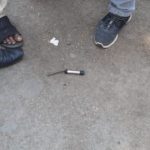A blanket of toxic haze shrouded the national capital region on Wednesday, as air quality in Delhi and the adjoining areas plunged to ‘very poor’ levels, affecting visibility and causing inconvenience to residents.
IMAGE: A hazy day at Rajpath in New Delhi. Photograph: ANI Photo
The Delhi government attributed the dip in the air quality to rampant stubble burning in neighbouring states, a regular feature in October-November.
The period between October 15 and November 15 is considered critical as maximum number of stubble burning incidents take place in this span in Punjab and adjoining states and is one of the main reasons for alarming spike in pollution in Delhi-NCR.
“Air quality in Delhi has been good or moderate for the last 7-8 months, but they (pollution levels) have starkly gone up now… Clearly, the sudden spike in pollution is a result of smoke coming from outside,” a Delhi government statement said.
A National Aeronautics and Space Administration satellite imagery late Wednesday evening showed a large number of fire spots due to stubble burning in Haryana, Punjab and western Uttar Pradesh.
According to the Central Pollution Control Board (CPCB), Delhi’s overall Air Quality Index (AQI) stood at 304 at 4 pm, with particulate matter less than 10 micrometers in diameter being the primary pollutant. On Tuesday, it was 270.
An India Meteorological Department official said that due to high concentration of dust, the visibility at Safdarjung reduced to 1,800 metres at 5.50 pm on Wednesday from 2,200 metres at 5.30 pm on Tuesday.
The Palam weather station recorded a drop of 1000 metres in visibility.
23 of the 37 air quality monitoring stations in Delhi recorded the AQI in the ‘very poor’ category.
The AQI at Dwarka Sector 8, Mundka, Bawana, Anand Vihar, Narela, Wazirpur, Vivek Vihar, Sirifort, Delhi Technological University, Nehru Nagar, Ashok Vihar, Rohini and Jahangirpuri was 365, 351, 349, 342, 341, 337, 336, 332, 331, 330, 329, 329 and 328.
Other areas where the air quality was very poor included Ayanagar (316), Burari Crossing (315), Alipur (315), Okhla Phase 2 (314), Punjabi Bagh (313), CRRI – Mathura Road (312), Jawaharlal Nehru Stadium (312), and ITO (309), NSIT-Dwarka (306), and Sonia Vihar (302).
The neighbouring areas of Ghaziabad (338), Loni Dehat (335), Noida (327), Baghpat (17), Greater Noida (308) and Faridabad (307) also recorded a spike in pollution levels.
An AQI between 0 and 50 is considered ‘good’, 51 and 100 ‘satisfactory’, 101 and 200 ‘moderate’, 201 and 300 ‘poor’, 301 and 400 ‘very poor’, and 401 and 500 ‘severe.
The South Delhi Municipal Corporation said it has issued 134 challans for burning of garbage, rubber and plastic waste and violation of solid waste management bylaws since Monday, when stricter anti-pollution measures under the Graded Response Action Plan (GRAP) kicked in.
Prepared by the CPCB, GRAP lists actions to be taken according to severity of pollution.
Bharatiya Janata Party MPs Manoj Tiwari and Gautam Gambhir flagged off 40 water sprinkling tankers, two super-sucker machines, six suction-cum-jetting machines, four auto-mounted litter picker machines, in a bid to reduce pollution levels in the city.
The Centre-run System of Air Quality and Weather Forecasting and Research (SAFAR) said the overall air quality of Delhi is in the lower end of the very poor category, with PM2.5 as the lead pollutant.
“This is the first time in the season that it entered this zone firmly and is likely to remain the same for next two days with a marginally increased magnitude,” it said in a report.
“The surface winds continue to be slow and variable with predominant direction from southeast. Hence, the dominant factor for the increase in pollution levels at this stage is changing local weather conditions rather than external intrusion,” it said.
Stubble burning incidents in Haryana, Punjab, and nearby border regions have shown an “increasing trend” over the last 48 hrs. Additionally, a few new fires have been observed over western Uttar Pradesh.
However, the wind direction is not favourable for the direct plume transport to Delhi.
SAFAR estimated that the share of crop residue burning in Delhi’s PM2.5 concentration was just 5 per cent on Wednesday.
The Delhi government on Tuesday shared pictures and data from NASA that showed large-scale stubble burning in areas surrounding Delhi.
Delhi Environment Minister Kailash Gehlot had written to Union Minister for Earth Sciences Harsh Vardhan, requesting access to SAFAR’s data so that the administration could take immediate corrective measures to curb pollution.
Earlier, the Supreme Court-mandated Environment Pollution (Prevention and Control) Authority said local sources of pollution, including stack emissions, dust, and burning of plastic and rubber waste, were the primary reason for deteriorating air quality in Delhi-NCR.
Via: PTI. All rights reserved. Republication or redistribution of PTI content, including by framing or similar means, is expressly prohibited without the prior written consent.




